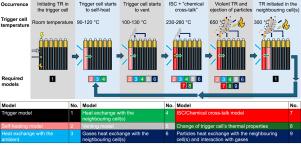A comprehensive review of thermal runaway and thermal runaway propagation modelling approaches in lithium-ion batteries
IF 8.9
2区 工程技术
Q1 ENERGY & FUELS
引用次数: 0
Abstract
The rapid shift to electric and hybrid vehicles has intensified the focus on Li-ion battery safety, especially regarding thermal runaway (TR) and its propagation (TRP). This comprehensive review examines the state-of-the-art in TR and TRP modelling approaches, aiming to improve safety and meet evolving standards. TR models typically use detailed Arrhenius-based reaction kinetics or simplified alternatives, with a strong emphasis on accurately capturing the highest energy release phase - chemical cross-talk. TRP models expand this to module and pack levels, incorporating heat transfer, venting, and spatial discretisation. The review summarises key methodologies, outlining their strengths, limitations, and areas for improvement. Visual aids, including TR and TRP modelling diagrams, help clarify complex mechanisms. Major findings highlight the dominance of chemical cross-talk in TR and the importance of heat conduction in TRP for pouch and prismatic cells. Future research should refine venting models to better capture convection effects, and consider variations in thermal properties, initial/boundary conditions, and cell ageing. Advancements in these areas can guide the development of more effective pack-level mitigation strategies, ultimately enhancing the safety and reliability of Li-ion batteries.

锂离子电池热失控和热失控传播建模方法综述
随着电动汽车和混合动力汽车的快速发展,人们越来越关注锂离子电池的安全性,尤其是热失控(TR)及其传播(TRP)问题。这项全面的审查审查了最先进的TR和TRP建模方法,旨在提高安全性并满足不断发展的标准。TR模型通常使用详细的基于arrhenius的反应动力学或简化的替代方法,重点是准确捕获最高能量释放相-化学串扰。TRP模型将其扩展到模块和包装水平,结合传热,通风和空间离散。该审查总结了关键的方法,概述了它们的优势、局限性和需要改进的领域。视觉辅助工具,包括TR和TRP建模图,有助于阐明复杂的机制。主要研究结果强调了化学串扰在TRP中的主导地位以及热传导在袋状细胞和柱状细胞TRP中的重要性。未来的研究应完善排气模型,以更好地捕捉对流效应,并考虑热性能、初始/边界条件和细胞老化的变化。这些领域的进展可以指导开发更有效的电池组级缓解策略,最终提高锂离子电池的安全性和可靠性。
本文章由计算机程序翻译,如有差异,请以英文原文为准。
求助全文
约1分钟内获得全文
求助全文
来源期刊

Journal of energy storage
Energy-Renewable Energy, Sustainability and the Environment
CiteScore
11.80
自引率
24.50%
发文量
2262
审稿时长
69 days
期刊介绍:
Journal of energy storage focusses on all aspects of energy storage, in particular systems integration, electric grid integration, modelling and analysis, novel energy storage technologies, sizing and management strategies, business models for operation of storage systems and energy storage developments worldwide.
 求助内容:
求助内容: 应助结果提醒方式:
应助结果提醒方式:


